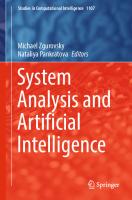Tools and Applications with Artificial Intelligence (Studies in Computational Intelligence, 166) 9783540880684, 9783540880691, 3540880682
In recent years, the use of Artificial Intelligence (AI) techniques has been greatly increased. The term “intelligence”
140 49 6MB
English Pages 223 [214]
Table of contents :
Title Page
Preface
Organization
Contents
Evaluation of Morphological Features for Breast Cells Classification Using Neural Networks
Introduction
Morphological Features
Methodology
Training and Testing Data
Optimum Neural Network Investigation
Results and Discussion
Conclusion
References
A BP-Neural Network Improvement to Hop-Counting for Localization in Wireless Sensor Networks
Introduction
Related Work
Problems
Hop-Counting Technique
Extending the Hop-Counting Technique
Neural Networks
NN-Based Hop Coordinates
Definition of Hop Coordinates
Constructing the Neural Network
Simulation
Simulation Process
Simulation Results
Costs
Summary and Conclusions
References
{\sc SUDOKUSAT}—A Tool for Analyzing Difficult Sudoku Puzzles
Sudoku
AI Escargot
Sudoku in AI
SAT-Based Sudoku Solving
GridAnalysis
{\sc SUDOKUSAT}
Results
Conclusions
References
Understanding and Forecasting Air Pollution with the Aid of Artificial Intelligence Methods in Athens, Greece
Introduction
Background
General Intro to Air Quality Analysis and Forecasting
The Greater Athens Area and Its AQ and Monitoring Stations
Data Presentation
Methodologies Applied
Covariance Calculation
Principal Component Analysis
Periodogram and Fourier Transform
Artificial Neural Networks
Results
Summary and Conclusions
References
Multiple Target Tracking for Mobile Robots Using the JPDAF Algorithm
Introduction
The JPDAF Algorithm for Multiple Target Tracking
The Particle Filter for Online State Estimation
Data Association
The JPDAF Algorithm
The JPDAF Algorithm for Multiple Robot Tracking
Simulation Results
Local Tracking for Non-maneuvering Movement
Local Tracking for Maneuvering Movement
Conclusion
References
An Artificial Market for Emission Permits
Introduction
Types of Auctions
A New Auction Type
An Artificial Market
Experimental Results
Conclusion
References
Application of Neural Networks for Investigating Day-of-the-Week Effect in Stock Market
Introduction
Data and Methodology
Application of Neural Networks Methods
Summary and Conclusions
References
WSRPS: A Weaning Success Rate Prediction System Based on Artificial Neural Network Algorithms
Introduction
Feature Selection
Methods
Data Sources
Artificial Neural Network
System Implementation
System Architecture and Flowchart
The BPD System Interface (Figure 4)
The WSRPS System Interface (Figure 7)
Results and Discussion
Outputs from the System
Performance Comparison from Three ANN Algorithms
Conclusions
References
Dealing with Large Datasets Using an Artificial Intelligence Clustering Tool
Introduction
Presentation of the Clustering Tool’s Algorithms
The Algorithm of Meyerson
The Fast Facility Location Algorithm
The k-Means Algorithm
The LocalSearch Algorithm
The Clustering Tool
Selection of the Algorithms
Input and Output File Options
Other Tool Options
Application on Synthetic Datasets
An Example of Using the Clustering Tool on a Synthetic Dataset
Conclusions and Future Work
References
An Application of Fuzzy Measure and Integral for Diagnosing Faults in Rotating Machines
Introduction
Faults in a Rotating Machine and Vibration Spectra
Faults in a Rotating Machine
Vibration Spectra
Positions and Directions for Spectra
Vibration Syndrome Matrix
Fuzzy Measure and Integral
Fuzzy Set of Spectra and Their Membership Functions
Fuzzy Measure for Spectra
Fuzzy Integral and the Possibility of Faults
Example of Diagnosis and Evaluation of the Method
Example of Diagnosis
Evaluation of the Method
Conclusion
References
A Multi-agent Architecture for Sensors and Actuators’ Fault Detection and Isolation in Case of Uncertain Parameter Systems
Introduction
Agents Description
Data Acquisition Agent
Detection Agents
Isolation Agents
User Interface Agent
Agents Structure
Communication
Simulation Example
Multi-agent System Implementation
Tests and Results
Conclusions and Future Work
References
A User-Friendly Evolutionary Tool for High-School Timetabling
Introduction
School Timetabling Problem Definition
Review of the Hosted Algorithm
The Timetabling Tool
An Example of Using the Timetabling Tool
Conclusions
References
HEPAR: An Intelligent System for Hepatitis Prognosis and Liver Transplantation Decision Support
Introduction
Problem Description
Liver Transplantation
Knowledge Modeling
Database Description
Database Descriptive Statistics
System Architecture and Design
Data Entry
Fuzzy Rules
Fuzzy Templates for Variable Modelling
Fuzzy Rule Description
Intermediate Rules
Prognosis Rules
Implementation Issues
FuzzyCLIPS 6.10d
Template Definition
Experimental Results
Related Work
Conclusions and Future Work
References
Improving Web Content Delivery in eGoverment Applications
Introduction
Motivation
Process and System Architecture
Technology Background
Case Study Implementation
Conclusions and Future Work
Appendix
References
Improving Text-Dependent Speaker Recognition Performance
Introduction
Speaker Verification Process
The Speaker Recognition System
The Speech Recognition Engine
The Speaker Verification Engine
Experimental Results
Experiment Setup
Recognition Performances
Conclusion
References
Author Index
Title Page
Preface
Organization
Contents
Evaluation of Morphological Features for Breast Cells Classification Using Neural Networks
Introduction
Morphological Features
Methodology
Training and Testing Data
Optimum Neural Network Investigation
Results and Discussion
Conclusion
References
A BP-Neural Network Improvement to Hop-Counting for Localization in Wireless Sensor Networks
Introduction
Related Work
Problems
Hop-Counting Technique
Extending the Hop-Counting Technique
Neural Networks
NN-Based Hop Coordinates
Definition of Hop Coordinates
Constructing the Neural Network
Simulation
Simulation Process
Simulation Results
Costs
Summary and Conclusions
References
{\sc SUDOKUSAT}—A Tool for Analyzing Difficult Sudoku Puzzles
Sudoku
AI Escargot
Sudoku in AI
SAT-Based Sudoku Solving
GridAnalysis
{\sc SUDOKUSAT}
Results
Conclusions
References
Understanding and Forecasting Air Pollution with the Aid of Artificial Intelligence Methods in Athens, Greece
Introduction
Background
General Intro to Air Quality Analysis and Forecasting
The Greater Athens Area and Its AQ and Monitoring Stations
Data Presentation
Methodologies Applied
Covariance Calculation
Principal Component Analysis
Periodogram and Fourier Transform
Artificial Neural Networks
Results
Summary and Conclusions
References
Multiple Target Tracking for Mobile Robots Using the JPDAF Algorithm
Introduction
The JPDAF Algorithm for Multiple Target Tracking
The Particle Filter for Online State Estimation
Data Association
The JPDAF Algorithm
The JPDAF Algorithm for Multiple Robot Tracking
Simulation Results
Local Tracking for Non-maneuvering Movement
Local Tracking for Maneuvering Movement
Conclusion
References
An Artificial Market for Emission Permits
Introduction
Types of Auctions
A New Auction Type
An Artificial Market
Experimental Results
Conclusion
References
Application of Neural Networks for Investigating Day-of-the-Week Effect in Stock Market
Introduction
Data and Methodology
Application of Neural Networks Methods
Summary and Conclusions
References
WSRPS: A Weaning Success Rate Prediction System Based on Artificial Neural Network Algorithms
Introduction
Feature Selection
Methods
Data Sources
Artificial Neural Network
System Implementation
System Architecture and Flowchart
The BPD System Interface (Figure 4)
The WSRPS System Interface (Figure 7)
Results and Discussion
Outputs from the System
Performance Comparison from Three ANN Algorithms
Conclusions
References
Dealing with Large Datasets Using an Artificial Intelligence Clustering Tool
Introduction
Presentation of the Clustering Tool’s Algorithms
The Algorithm of Meyerson
The Fast Facility Location Algorithm
The k-Means Algorithm
The LocalSearch Algorithm
The Clustering Tool
Selection of the Algorithms
Input and Output File Options
Other Tool Options
Application on Synthetic Datasets
An Example of Using the Clustering Tool on a Synthetic Dataset
Conclusions and Future Work
References
An Application of Fuzzy Measure and Integral for Diagnosing Faults in Rotating Machines
Introduction
Faults in a Rotating Machine and Vibration Spectra
Faults in a Rotating Machine
Vibration Spectra
Positions and Directions for Spectra
Vibration Syndrome Matrix
Fuzzy Measure and Integral
Fuzzy Set of Spectra and Their Membership Functions
Fuzzy Measure for Spectra
Fuzzy Integral and the Possibility of Faults
Example of Diagnosis and Evaluation of the Method
Example of Diagnosis
Evaluation of the Method
Conclusion
References
A Multi-agent Architecture for Sensors and Actuators’ Fault Detection and Isolation in Case of Uncertain Parameter Systems
Introduction
Agents Description
Data Acquisition Agent
Detection Agents
Isolation Agents
User Interface Agent
Agents Structure
Communication
Simulation Example
Multi-agent System Implementation
Tests and Results
Conclusions and Future Work
References
A User-Friendly Evolutionary Tool for High-School Timetabling
Introduction
School Timetabling Problem Definition
Review of the Hosted Algorithm
The Timetabling Tool
An Example of Using the Timetabling Tool
Conclusions
References
HEPAR: An Intelligent System for Hepatitis Prognosis and Liver Transplantation Decision Support
Introduction
Problem Description
Liver Transplantation
Knowledge Modeling
Database Description
Database Descriptive Statistics
System Architecture and Design
Data Entry
Fuzzy Rules
Fuzzy Templates for Variable Modelling
Fuzzy Rule Description
Intermediate Rules
Prognosis Rules
Implementation Issues
FuzzyCLIPS 6.10d
Template Definition
Experimental Results
Related Work
Conclusions and Future Work
References
Improving Web Content Delivery in eGoverment Applications
Introduction
Motivation
Process and System Architecture
Technology Background
Case Study Implementation
Conclusions and Future Work
Appendix
References
Improving Text-Dependent Speaker Recognition Performance
Introduction
Speaker Verification Process
The Speaker Recognition System
The Speech Recognition Engine
The Speaker Verification Engine
Experimental Results
Experiment Setup
Recognition Performances
Conclusion
References
Author Index

- Author / Uploaded
- Constantinos Koutsojannis (editor)
- Spiros Sirmakessis (editor)









